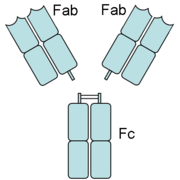
Fragment crystallizable region
Encyclopedia

Antibody
An antibody, also known as an immunoglobulin, is a large Y-shaped protein used by the immune system to identify and neutralize foreign objects such as bacteria and viruses. The antibody recognizes a unique part of the foreign target, termed an antigen...
that interacts with cell surface receptors called Fc receptor
Fc receptor
An Fc receptor is a protein found on the surface of certain cells - including natural killer cells, macrophages, neutrophils, and mast cells - that contribute to the protective functions of the immune system....
s and some proteins of the complement system
Complement system
The complement system helps or “complements” the ability of antibodies and phagocytic cells to clear pathogens from an organism. It is part of the immune system called the innate immune system that is not adaptable and does not change over the course of an individual's lifetime...
. This property allows antibodies to activate the immune system
Immune system
An immune system is a system of biological structures and processes within an organism that protects against disease by identifying and killing pathogens and tumor cells. It detects a wide variety of agents, from viruses to parasitic worms, and needs to distinguish them from the organism's own...
. In IgG, IgA
IGA
Iga or IGA may stand for:-Given name:* a female given name of Polish origin. The name originates from the female given name Jadwiga and stands for gia,or gina in the USA....
and IgD
IGD
IGD can refer to:*Internet Gateway Device as defined in UPnP.*İGD, İlerici Gençler Derneği, Progressive Young Association of Turkey*Immunoglobulin D, an antibody protein involved in the maturation of B cells....
antibody isotype
Isotype
Isotype can refer to:* In crystallography, an "isotype" is a synonym for isomorph* In biology, per the International Code of Botanical Nomenclature, the "isotype" is a duplicate of the holotype....
s, the Fc region is composed of two identical protein fragments, derived from the second and third constant domains of the antibody's two heavy chains; IgM
IGM
IGM as an acronym or abbreviation can refer to:* Immunoglobulin M , the primary antibody against A and B antigens on red blood cells* International Grandmaster, a chess ranking* intergalactic medium* Intragroup medium - see: Intracluster medium...
and IgE
IGE
IGE was one of the largest services company buying and selling virtual currencies and accounts for MMORPG. During its peak time, it had offices in Los Angeles, China , and headquarters & customer service centre in Hong Kong. IGE was one of the main monopoly in virtual economy services, also known...
Fc regions contain three heavy chain constant domains (CH domains 2–4) in each polypeptide chain.
The Fc regions of IgGs bear a highly conserved N-glycosylation site. Glycosylation
Glycosylation
Glycosylation is the reaction in which a carbohydrate, i.e. a glycosyl donor, is attached to a hydroxyl or other functional group of another molecule . In biology glycosylation refers to the enzymatic process that attaches glycans to proteins, lipids, or other organic molecules...
of the Fc fragment is essential for Fc receptor-mediated activity. The N-glycans
Glycosidic bond
In chemistry, a glycosidic bond is a type of covalent bond that joins a carbohydrate molecule to another group, which may or may not be another carbohydrate....
attached to this site are predominantly core-fucosylated
Fucose
Fucose is a hexose deoxy sugar with the chemical formula C6H12O5. It is found on N-linked glycans on the mammalian, insect and plant cell surface, and is the fundamental sub-unit of the fucoidan polysaccharide...
diantennary structures of the complex type. In addition, small amounts of these N-glycans also bear bisecting GlcNAc and α-2,6 linked sialic acid
Sialic acid
Sialic acid is a generic term for the N- or O-substituted derivatives of neuraminic acid, a monosaccharide with a nine-carbon backbone. It is also the name for the most common member of this group, N-acetylneuraminic acid...
residues.
The other part of an antibody, called the Fab region, contains variable sections that define the specific target that the antibody can bind. By contrast, the Fc region of all antibodies in a class are the same for each species; they are constant rather than variable. The Fc region is, therefore, sometimes incorrectly termed the "fragment constant region".
Function
Fc binds to various cell receptorReceptor (biochemistry)
In biochemistry, a receptor is a molecule found on the surface of a cell, which receives specific chemical signals from neighbouring cells or the wider environment within an organism...
s and complement
Complement system
The complement system helps or “complements” the ability of antibodies and phagocytic cells to clear pathogens from an organism. It is part of the immune system called the innate immune system that is not adaptable and does not change over the course of an individual's lifetime...
proteins. In this way, it mediates different physiological effects of antibodies (Detection of opsonized particles
Antibody opsonization
Is the process by which a pathogen is marked for ingestion and destruction by a phagocyte. Opsonization involves the binding of an opsonin, e.g., antibody, to a receptor on the pathogen's cell membrane. After opsonin binds to the membrane, phagocytes are attracted to the pathogen...
; cell lysis
Lysis
Lysis refers to the breaking down of a cell, often by viral, enzymic, or osmotic mechanisms that compromise its integrity. A fluid containing the contents of lysed cells is called a "lysate"....
; degranulation
Degranulation
Degranulation is a cellular process that releases antimicrobial cytotoxic molecules from secretory vesicles called granules found inside some cells...
of mast cells, basophils, and eosinophils; and other processes).

